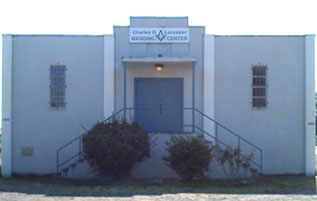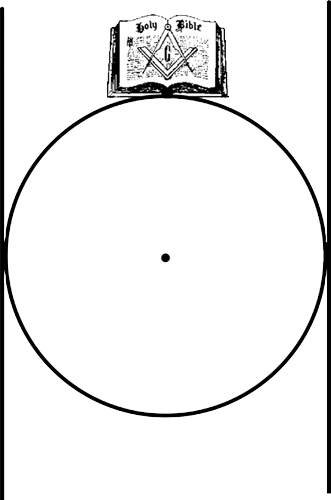



















A Biography of Saint John the Baptist
from The Southern California Research Lodge F&AM
by RW Sydney Grunberg PDDGM, California
Saint John the Baptist, the forerunner of Jesus, was a son of
the Jewish priest Zacharias and of Elizabeth, who was a zealous judge of
morality and undaunted preacher of repentance, obtained great celebrity, first
in his native country, then in the mountains of Judea, and afterwards among the
whole nation. His simple and abstemious manner of living contributed much to his
fame, and especially the peculiar purification or consecration by baptism in a
river bath, which he introduced as a symbol of that moral purity which he so
zealously inculcated. Jesus allowed himself to be baptized by him, and from that
time forward, John said unto his disciples that Jesus was certainly the Messiah.
The frank earnestness and the great fame with which he preached even in Galilee
soon brought upon him the suspicion and hatred of the court of Tetrarch Antipas,
or King Herod, who imprisoned him, and on the 29th of August, in the
thirty-second or thirty third year of his life, caused him to be beheaded. The
24th of June, his birthday, is dedicated to his memory through all Christendom.
The patron Saint of the Freemasons' brotherhood was formerly not Saint John the
Baptist, but Saint John the Evangelist, whose festival they celebrate on the
27th of December, upon which day they held their general assembly, probably
induced thereto because at this season of the year, the members could be better
spared from their business or profession. For this reason, they chose for their
quarterly festivals the annunciation of the Virgin Mary, Michaelmas, and the
festival of Saint John the Baptist, which last festival, on account of the
better weather and other circumstances having been found to be more convenient
for the yearly assembly, was often appointed for the time on which it should be
held, so that it has become nearly general. Many Lodges still celebrate the 27th
of December and call it the minor Saint John's Day.
Among the peoples of the many nations, it has been a custom for ages to dedicate
every temple, statue, altar, public building, or sacred place to some divinity,
usually some saint or outstanding character whose work for a society has aided
in its establishment.
The ancient Romans confided this duty to their consuls, pretors, censors, to
other chief magistrates and afterward, to the emperors. Many such edifices were
dedicated to some patron saint as also were different religious faiths, and even
during the colonial times the Masonic Lodges in England were dedicated to Saint
John while the Scotch dedicated theirs to Saint Andrews. The first two Lodges in
Boston were so divided.
While the different religions dedicated their churches to their different
saints, among the Jews, from their first history, all their places for worship
were dedicated to the one God, Jehovah. So with Masonry, for many years, it was
dedicated to King Solomon for he was the first Grand Master, but later, from the
11th to the 15th centuries, it was dedicated to Saint John the Baptist and was
know as the Lodge of the Holy Saint of Jerusalem. It was during the 15th century
that Saint John the Evangelist was so recognized and from that time, Masonry has
been dedicated to the Holy Saints John, including both.
Until just a few years ago, it was not know that John the Baptist had any
connection with Masonry or why he should be so honored, but upon the discovery
of the ancient scrolls of he Essenes at Qumram, it was established that he was a
member of the society of Essenes and had served as chaplain or priest. The fact
that he baptized was his qualification as a priest. While it has not been
definitely established that the society of Essenes was the same as Masonry,
there is a great similarity between the two, the moral teachings of both are the
same. The charity of both, as well as the practice of Brotherly Love, were
identical.

A Biography of Saint John the Evangelist
from The Southern California Research Lodge F&AM
by RW Sydney Grunberg PDDGM
Saint John the Evangelist and apostle of Jesus, whose gospel is
so important to all Freemasons, was born in Bethaida, in Galilee, AD99. A son of
Zebedee, a Galilean fisherman, and to Salome, throughout the New Testament, he
is referred to as being a disciple of Jesus, who loved him because he
distinguished himself by his gentleness and humility.
He was a much different type than John the Baptist. He was more calm and
thoughtful, only arriving at a decision after careful study, and never
threatened, but tried to win by persuasion.
After the ascension of Jesus, he returned to Patmos. After the Crucifixion, he
returned from exile to Asia Minor and settled at Ephesus, where it is probable
that he died at a very old age. He was a man of great energy and poetic fire and
life; in his early years somewhat haughty and intolerant, but afterwards an
example of love. However, there was one incident told in the Gospel where his
good judgment was overcome by his hasty action. He, with other disciples, had
accompanied Jesus to a village whose residents were mostly Samaritans, between
whom and the people there was little feeling. So when the Samaritans refused to
receive or listen to Jesus and his disciples, James and John asked permission to
pray for fire to come down and destroy them. Jesus not only refused their
request, but rebuked them for such thought, saying "Ye know knot what manner of
spirit ye are of. For the Son of Man is not come to destroy men's lives but to
save them."
In the 2nd century, John the apostle was identified by Justin with the prophet
John who suffered on the island of Patmos, wrote the Book of Revelation. Yet, in
Revelation 21:14, that writer implicitly differentiates himself from the group
of twelve apostles. An even stronger tradition was reported by Irenaeus in which
John is identified as the unnamed Beloved Disciple of Jesus, who was the source
of the Fourth Gospel and, hence, an evangelist. The title "John the Divine"
designates him a theologian because of the quality of the Gospel.
The Beloved Disciple seemingly lived a long life and did not die a martyr, hence
the tradition that john lived at Ephesus in Asia Minor until early in the reign
of Trajan (98 -117 AC). Irenaeus has him confronting the heretic Cerinthus in
the public baths there, perhaps a legendary recollection of the type of
doctrinal conflict found in the Epistles of John. Tertullian says that John was
taken from Ephesus to Rome and cast into a cauldron of boiling oil before the
Latin Gate. Other ancient legends have him raising a dead man to life,
reclaiming a robber for Christ, and constantly repeating in his old age, "Little
children, love one another."
Of the four figurative representations of the evangelists based on Ezekiel 1:10
and Revelation 4:7, John was depicted as an eagle because of the soaring
theology of the Gospel prologue.
The Gospel of Saint John the Evangelist is especially important to the
Freemasons, for he preached love, and his book contains all the fundamental
doctrines of Freemasonry. As a Freemason ought never to forget that he has laid
his hand upon the Gospel of Saint John, so should he never cease to love his
Brethren according to the doctrine of love contained in that sacred book. Many
Lodges celebrate his anniversary, the 27th of December.
The primary purpose of commemorating these patrons is to remind Masons of their
obligations, to weed evil out of their lives and to nurture and cultivate their
finest strains. It also reminds them that his can best be done through
friendship, understanding, and mutual aid.